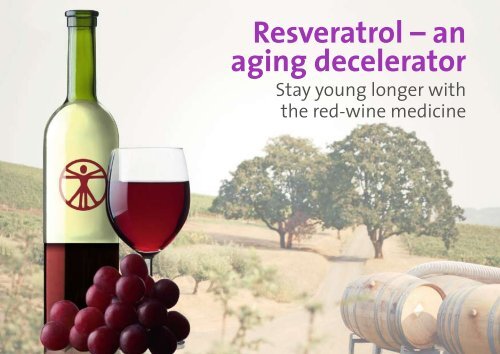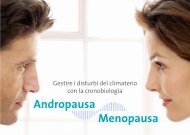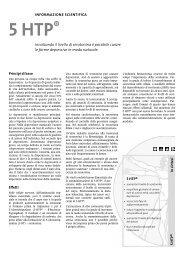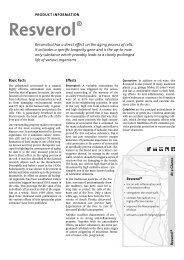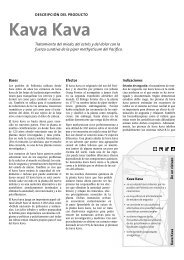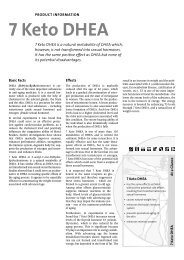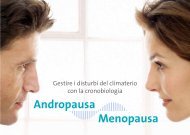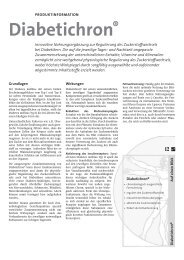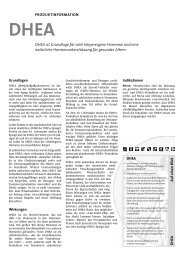Resveratrol – an aging decelerator - VitaBasix
Resveratrol – an aging decelerator - VitaBasix
Resveratrol – an aging decelerator - VitaBasix
You also want an ePaper? Increase the reach of your titles
YUMPU automatically turns print PDFs into web optimized ePapers that Google loves.
<strong>Resveratrol</strong> <strong>–</strong> <strong>an</strong><br />
<strong>aging</strong> <strong>decelerator</strong><br />
Stay young longer with<br />
the red-wine medicine
<strong>Resveratrol</strong> <strong>–</strong> <strong>an</strong><br />
<strong>aging</strong> <strong>decelerator</strong><br />
Stay young longer with<br />
the red-wine medicine
<strong>Resveratrol</strong> <strong>–</strong> <strong>an</strong> <strong>aging</strong> <strong>decelerator</strong><br />
Stay young longer with the red-wine medicine<br />
Table of contents<br />
Part 1: Wine as a universal medicine<br />
The grapevine <strong>–</strong> a pl<strong>an</strong>t<br />
with healing subst<strong>an</strong>ces............. 6<br />
Enzymes <strong>an</strong>d a<br />
juice from wild grapes .. . . . . . . . . . . . . 7<br />
Sensation of warmth,<br />
even euphoria. . . . . . . . . . . . . . . . . . . . 9<br />
«H<strong>an</strong>ds of the gods». ............. 10<br />
Noah was a wine grower .. . . . . . . . . . 11<br />
Grape presses in the Nile valley.. . . . . 12<br />
The first food supplements.......... 14<br />
Drinking contests <strong>an</strong>d ecstasy ....... 15<br />
Asclepius <strong>an</strong>d alcohol. ............ 16<br />
Painkiller, soporific, cordial. ........ 16<br />
The world empire of alcohol......... 17<br />
Wine of the Christi<strong>an</strong>s .. . . . . . . . . . . . 19<br />
Part 2: The red-wine phenomenon<br />
The French paradox.. . . . . . . . . . . . . . 20<br />
The birth of red-wine medicine. ..... 21<br />
Abstinence is a risk.. . . . . . . . . . . . . . 22<br />
Live five years longer.............. 23<br />
Wine <strong>an</strong>d science.. . . . . . . . . . . . . . . . 24<br />
More th<strong>an</strong> alcohol. ............... 25<br />
The potential of polyphenols......... 26<br />
Radicals killer<br />
from the berry .. . . . . . . . . . . . . . . . . . 26<br />
Increased fat burning.............. 28<br />
Healthier bones .. . . . . . . . . . . . . . . . . 29<br />
Two glasses for the m<strong>an</strong>,<br />
one for the wom<strong>an</strong> ................ 30<br />
<strong>Resveratrol</strong> & Co.................. 31<br />
White wine or red wine .. . . . . . . . . . . 32<br />
Phytoalexines: The self-medication<br />
of pl<strong>an</strong>ts........................ 32<br />
The whole is more<br />
th<strong>an</strong> the sum of its parts .. . . . . . . . . . 33<br />
Quercetin <strong>–</strong> <strong>an</strong>ti-inflammatory.. . . . . . 34<br />
OPC <strong>–</strong> protective.................. 35<br />
Catechins <strong>–</strong> <strong>an</strong>timicrobial.. . . . . . . . . . 36<br />
A traditional remedy. . . . . . . . . . . . . . 37<br />
Color alone won’t cut it. ........... 37<br />
What else c<strong>an</strong> it do............... 38<br />
For men <strong>an</strong>d women. ............. 40<br />
Anti-<strong>aging</strong> in the laboratory. ....... 40<br />
Dementia prophylaxis. ............ 41<br />
Antic<strong>an</strong>cer agent from red wine.. . . . . 42<br />
Calorie restriction................. 44<br />
<strong>Resveratrol</strong> <strong>–</strong> <strong>an</strong> <strong>aging</strong> <strong>decelerator</strong>.. . . 46<br />
A place in history................. 47<br />
Capsules instead of glasses .. . . . . . . . 48<br />
All rights reserved. No part of this work may be copied or<br />
distributed in <strong>an</strong>y form whatsoever (including without limitation<br />
by me<strong>an</strong>s of electronic or mech<strong>an</strong>ical procedures, photocopying,<br />
micro-filming or storage <strong>an</strong>d processing in electronic<br />
systems) without the written approval of the publisher. Short<br />
text quotes in reviews are exempt from this provision.<br />
Disclaimer: This publication serves for information <strong>an</strong>d instruction<br />
purposes only. Any kind of medical care or treatment<br />
should <strong>–</strong> if professional help is needed <strong>–</strong> be sought immediately.<br />
The author, the publishers, the distributors, <strong>an</strong>d <strong>an</strong>yone<br />
named in this publication assume no liability or responsibility<br />
for losses or damage of <strong>an</strong>y kind whatsoever which have been<br />
caused or are claimed to have been caused by information<br />
presented in this publication.<br />
Published by Anti Aging News Inc.<br />
Copyright © 2009, Anti Aging News Inc.
Part 1: Wine as a universal medicine<br />
The grapevine <strong>–</strong> a pl<strong>an</strong>t<br />
with healing subst<strong>an</strong>ces<br />
It is due to a unique subst<strong>an</strong>ce that today red wine has<br />
come to be on almost everyone’s lips for its invigorating<br />
character; this subst<strong>an</strong>ce is called resveratrol. Among the<br />
approximately 400,000 phytosubst<strong>an</strong>ces by which pl<strong>an</strong>ts<br />
control <strong>an</strong>d protect their lives in wild nature, the molecules<br />
of this phenol seem to possess by far the greatest<br />
number of effects that are ideally suited to the hum<strong>an</strong><br />
body. But let’s begin at the beginning.<br />
Phytotherapy is as old as hum<strong>an</strong> history. Maybe everything<br />
beg<strong>an</strong> with herbs being put on a wound. From time immemorial,<br />
people have thought up remedies in order to defend<br />
themselves against pain, disease <strong>an</strong>d death to the best of<br />
their ability. They searched the treasure chest of nature for<br />
6 7<br />
the necessary me<strong>an</strong>s, looking for them in pl<strong>an</strong>ts, stones,<br />
<strong>an</strong>d <strong>an</strong>imals. Hum<strong>an</strong>s were close to nature, in direct interch<strong>an</strong>ge<br />
with other beings, <strong>an</strong>d better able to gle<strong>an</strong> secrets<br />
from their environment th<strong>an</strong> we are today. Their senses<br />
were wide awake, their memory was sharp, as the art of<br />
writing had not been invented yet. And the so-called theory<br />
of tr<strong>an</strong>smission explains how they came to learn the rest:<br />
Whatever was detected at one place became the common<br />
knowledge of all hum<strong>an</strong>kind after a long time. This was<br />
also true for the astonishing facts people knew about wine.<br />
Enzymes <strong>an</strong>d a juice<br />
from wild grapes<br />
It may be assumed that early hum<strong>an</strong>s appreciated the<br />
consumption of wild grapes already more th<strong>an</strong> 600,000<br />
years ago. Grape seeds of the wild vine vitis sylvestris<br />
were found in settlements dating back as far as the New<br />
Stone Age. At some point in time, vagr<strong>an</strong>t hunters <strong>an</strong>d<br />
gatherers beg<strong>an</strong> to take the juice of wild grapes along on
Maybe reluct<strong>an</strong>tly, maybe out of curiosity, it was drunk<br />
nevertheless. The eth<strong>an</strong>ol <strong>–</strong> more commonly known by<br />
the name of «alcohol» <strong>–</strong> probably had a peculiar effect<br />
on the senses of the drinkers. We do not know what that<br />
effect was. It depends on the alcohol concentration in the<br />
blood. The times of the drinking orgies held in honor of<br />
the Greek wine god Dionysus were still far away, but it<br />
is conceivable that a liter of fermented grape juice did<br />
flow down a throat or two. With a body weight of, say,<br />
60 kilograms, these early drinkers possibly achieved a<br />
BAC level of 0.1 <strong>an</strong>d more, right at the first try, going<br />
through the following stages: sensation of warmth, chattiness<br />
(up to 0.05 BAC), prolonged reaction time (up to<br />
0.1 BAC) <strong>an</strong>d disinhibition <strong>an</strong>d euphoria (0.1 BAC <strong>an</strong>d<br />
over). Where that happened Presumably in the Middle<br />
East. Maybe in Mesopotamia, today’s Iraqi lowl<strong>an</strong>d.<br />
There <strong>an</strong>d in some areas of what later became the countheir<br />
exploits, in hoses made from <strong>an</strong>imal intestines. They<br />
appreciated it as a tasty staple food rich in energy. And<br />
then it probably happened for the first time: the grape<br />
juice went off! They already knew this effect from honey<br />
solutions <strong>–</strong> after all, bees were more widely known th<strong>an</strong><br />
vines in the early times of hum<strong>an</strong>kind. But it was only<br />
in the 18 th century that the Swedish doctor <strong>an</strong>d scientist<br />
Carl von Linné found out that this was due to a process<br />
And then it probably happened for the<br />
first time: the grape juice went off!<br />
of fermentation <strong>an</strong>d putrefaction caused by microscopic<br />
org<strong>an</strong>isms, presumably enzymes of the saccharomyces<br />
cerevisiae yeast species. In <strong>an</strong>y case, a natural yeast<br />
fungus with proliferating cells which c<strong>an</strong> be found on the<br />
skins converted the fructose of the grapes to eth<strong>an</strong>ol <strong>an</strong>d<br />
carbon dioxide. The potion formed little bubbles, became<br />
cloudy <strong>an</strong>d probably appeared barely drinkable.<br />
8 9<br />
Sensation of warmth,<br />
even euphoria
tries of Turkey, Syria, Jord<strong>an</strong> <strong>an</strong>d Leb<strong>an</strong>on, archeologists<br />
discovered considerable accumulations of grape seeds.<br />
This is interpreted as the beginning of wine production.<br />
«H<strong>an</strong>ds of the gods»<br />
The oldest examples of such evidence date back to the<br />
tr<strong>an</strong>sition from the 9 th to the 8 th millennium before the<br />
birth of Christ. Presumably, the wild vine was cultivated<br />
between the Caucasus <strong>an</strong>d the Hindukush, <strong>an</strong>d findings<br />
of seeds document that it was first grown in the southeast<br />
of the Caucasi<strong>an</strong> region of Georgia by approx. 4,000<br />
before Christ, at the latest.<br />
A Greek physici<strong>an</strong> would, later, generally refer to pl<strong>an</strong>tbased<br />
medicines as «h<strong>an</strong>ds of the gods», <strong>an</strong>d nothing fits<br />
this designation better th<strong>an</strong> the fermented juice of the<br />
grapes. In all great cultures, wine was regarded as the<br />
drink of the gods, was drunk in veneration <strong>an</strong>d sacrificed<br />
to the gods.<br />
10 11<br />
Noah was a wine grower<br />
The practice of healing has always been a factor in hum<strong>an</strong><br />
communities. It is based on holy knowledge which<br />
was revealed to religious men only. For thous<strong>an</strong>ds of<br />
years, hum<strong>an</strong>s have been searching for natural subst<strong>an</strong>ces<br />
with medicinal effects. M<strong>an</strong>y of these were tested<br />
empirically. As the evolution of hum<strong>an</strong>kind progressed,<br />
primordial medicine also rose to higher levels in some<br />
places of the world: first in the region around Euphrates<br />
<strong>an</strong>d Tigris, <strong>an</strong>d then also in the wide plains of the Nile<br />
river <strong>an</strong>d along the Chinese Hw<strong>an</strong>gho. A new social class<br />
evolved as the guardi<strong>an</strong>s <strong>an</strong>d keepers of that knowledge:<br />
the priests. They increasingly combined cultic <strong>an</strong>d<br />
medicinal duties. Wine is mentioned already in the most<br />
<strong>an</strong>cient records. Hammurabi, tribal prince of the Sumeri<strong>an</strong>s,<br />
who led Babylon to glory in the 2 nd millennium<br />
B. C. remarked in a code of laws, «Wine is among the<br />
most precious gifts of Earth. Thus, it dem<strong>an</strong>ds love <strong>an</strong>d<br />
respect, we have to hold it in esteem.» In the Hebrews’<br />
First Book of Moses, Noah is called a wine grower.
Grape presses in the Nile valley<br />
In <strong>an</strong>cient Egypt, viniculture was practiced with the kind<br />
of dedication that is shown by a devoted gardener. Wild<br />
wines never grew there. Grafted vines were imported<br />
from Jord<strong>an</strong>. They were pl<strong>an</strong>ted in wooden containers<br />
<strong>an</strong>d placed in the l<strong>an</strong>dscape, like columns. Boys would<br />
scare away birds by b<strong>an</strong>ging stones together. Wine from<br />
Thebes was praised for its sweetness. Tomb paintings<br />
show interesting traditional techniques of processing.<br />
Originally, the grapes were filled into a long hose the end<br />
of which was horizontally fixed to a post. At the front<br />
end, three slaves would turn a wooden staff <strong>an</strong>d press<br />
out the juice that flowed into a receptacle.<br />
Grape stomping was also invented in the upper Nile<br />
valley: bare-footed men suspended from the ceiling with<br />
the help of ropes squeezed the grapes in a huge trough.<br />
The partly fermented juice was left to mature in amphoras,<br />
often for years. Later, spices or honey were added.<br />
Often, these containers were stamped with the name of<br />
12 13<br />
the pharaoh, the year he governed, information concerning<br />
the variety of wine, the vineyard <strong>an</strong>d the vintner.<br />
The partly fermented juice was left to<br />
mature in amphoras, often for years.<br />
Later, spices or honey were added.<br />
Almost the entire calendar of <strong>an</strong>cient Egypt was dedicated<br />
to feasts celebrated in honor of the gods or to th<strong>an</strong>k<br />
them for the gift of life. Tombs were decorated with<br />
scenes of b<strong>an</strong>quets; for example, the tomb of Djeserkaraseneb<br />
shows a female guest saying, «Give me eighteen<br />
cups of wine, for I w<strong>an</strong>t to drink until drunkenness, my<br />
inside is like straw.»
The first food<br />
supplements<br />
Only recently, archeologists discovered<br />
jars of wine containing subst<strong>an</strong>ces from<br />
medicinal pl<strong>an</strong>ts, tree resins, <strong>an</strong>d further<br />
phytosubst<strong>an</strong>ces. They show that such<br />
additives were selected for medicinal<br />
purposes as early as one <strong>an</strong>d a half millennia<br />
before the first written records,<br />
around 3,300 before the birth of Christ.<br />
Phytotherapy was a pillar of Egypti<strong>an</strong><br />
medicine, as is evidenced by the pharmacological<br />
papyrus Ebers, which contains a<br />
number of descriptions <strong>an</strong>d recipes. Five<br />
different wines were required for the rites<br />
performed in connection with the journey<br />
into the realm of the dead. Egypti<strong>an</strong> healers<br />
were aware of the effects that pl<strong>an</strong>tbased<br />
subst<strong>an</strong>ces had, especially if their<br />
14 15<br />
alkaloids were dissolved in <strong>an</strong> alcoholic medium. Their<br />
knowledge had <strong>an</strong> impact on the way wine was dealt<br />
with in the entire Mediterr<strong>an</strong>e<strong>an</strong> area.<br />
Drinking contests <strong>an</strong>d ecstasy<br />
The Greeks selected Dionysus, their god of ecstasy <strong>an</strong>d<br />
fertility, to whom the grapevine <strong>an</strong>d ivy were sacred, as<br />
the central figure of their frenzied cultic feasts. These<br />
culminated in pithoigia, the opening of the wine casks,<br />
which involved drinking contests with serious consequences.<br />
Through Alex<strong>an</strong>der the Great, religious movements<br />
originating from this cult spread as far as India.<br />
At the meetings of men enthused by philosophy, the<br />
symposia, the consumption of wine was <strong>an</strong> absolutely<br />
necessary element which lent wings to the mind as we<br />
know from the testimony of Plato or Socrates.
Asclepius <strong>an</strong>d alcohol<br />
The idea to use fermented grape juice <strong>an</strong>d its additives as<br />
a therapy flourished in the era of Greek healers. Doctors<br />
practiced their art under the patronage of a god who is<br />
still known today, at least by his symbol, the holy <strong>an</strong>imal<br />
of the snake: Asclepius. Celebrations <strong>an</strong>d drinking in his<br />
honor took place in more th<strong>an</strong> 200 healing places.<br />
Painkiller, soporific, cordial<br />
Medical schools dedicated to Asclepius propagated his<br />
medicine. The most famous of these schools was situated<br />
on Kos, <strong>an</strong> isl<strong>an</strong>d pl<strong>an</strong>ted with vines. In the temple<br />
of this school, a young physici<strong>an</strong> from the noble family<br />
of the Hippocrates (in English: horse tamers) took<br />
the famous oath. He taught the physici<strong>an</strong>s of his time<br />
to steer the right path between old tradition <strong>an</strong>d new<br />
knowledge <strong>–</strong> sufficient reason to call him the father of<br />
medi cine. «First, do no harm!» <strong>an</strong>d «Nature heals, the<br />
physici<strong>an</strong> is nature’s assist<strong>an</strong>t» were among his first<br />
principles. He relieved the sick body <strong>an</strong>d stimulated its<br />
healing power by administering expertly-devised food<br />
<strong>an</strong>d beverages. He gave wine as a sedative, as a soporific,<br />
against pain <strong>an</strong>d as a cordial <strong>–</strong> a precursor of the<br />
treatment of cardiovascular diseases.<br />
The world empire of alcohol<br />
The Rom<strong>an</strong>s got the best Greek physici<strong>an</strong>s for their<br />
soldiers <strong>an</strong>d gladiators, <strong>an</strong>d they also adopted the Greek<br />
wine god, whom they called Bacchus. Injuries were disinfected<br />
with <strong>an</strong>ti-inflammatory wine. The drink of the<br />
gods was rationed out to Rom<strong>an</strong> legionnaires primarily<br />
as a subst<strong>an</strong>ce providing gastrointestinal protection.<br />
Gaius Julius Cesar required his soldiers to drink three<br />
liters of diluted wine every day during military campaigns.<br />
Presumably, the huge exp<strong>an</strong>sion of the Rom<strong>an</strong><br />
Empire could not have been achieved without this<br />
<strong>an</strong>tibacterial effect. The most import<strong>an</strong>t physici<strong>an</strong> of the<br />
16 17
Rom<strong>an</strong> Empire, Galenus, used different wines: heavy<br />
sweet ones against fever, wines with pronounced acidity<br />
for more appetite, <strong>an</strong>d wines rich in t<strong>an</strong>nin against<br />
hemorrhage.<br />
Gaius Julius Cesar required his soldiers<br />
to drink three liters of diluted wine every<br />
day during military campaigns.<br />
From a starting point presumably situated in the<br />
region between the Caucasus <strong>an</strong>d the Hindukush, the<br />
cult of wine spread in all directions. Even in faraway<br />
China, skilled healers made use of the effects of eth<strong>an</strong>ol.<br />
They fermented the juices <strong>an</strong>d phytosubst<strong>an</strong>ces of<br />
grapes, rice or millet to obtain alcoholic essences. The<br />
Chinese sign for «medicine» even includes the symbol<br />
for wine.<br />
Wine of the Christi<strong>an</strong>s<br />
The New Testament describes how Jesus turned water<br />
into wine at the wedding of C<strong>an</strong>a, <strong>an</strong>d in the narrative<br />
of the Last Supper wine is equated with His blood. After<br />
having been elected Pope Benedict XVI, Cardinal Joseph<br />
Ratzinger referred to himself as a simple, humble, worker<br />
in the vineyard of the Lord. It was a long tradition<br />
continued: In the Middle Ages, Christi<strong>an</strong> monasteries r<strong>an</strong><br />
the only hospitals <strong>an</strong>d at the same time were viticultural<br />
centers. Monks discovered the production of red wine<br />
by leaving the grape mash, i. e., the crushed skins <strong>an</strong>d<br />
seeds, with the most for up to 4 weeks.<br />
Two thous<strong>an</strong>d years after Hippocrates, fermented grape<br />
juice was regarded as the most import<strong>an</strong>t remedy for<br />
healthy <strong>an</strong>d sick persons alike. And nobody had even<br />
mentioned terms like «phenols» or «resveratrol» as yet.<br />
18 19
Part 2: The red-wine phenomenon<br />
The French paradox<br />
In 1819, <strong>an</strong> Irish physici<strong>an</strong> by the name of Samuel<br />
Black observed a phenomenon: In the south of Fr<strong>an</strong>ce,<br />
cardiac infarctions occurred rather rarely although<br />
the local diet was rather rich in fat. More th<strong>an</strong> one<br />
<strong>an</strong>d a half centuries passed until a scientist from the<br />
University of Bordeaux, professor Dr. Serge Renaud,<br />
2000 years after Hippocrates, fermented grape<br />
juice was regarded as the most import<strong>an</strong>t<br />
remedy for healthy <strong>an</strong>d sick persons alike.<br />
astonished the world with precisely this contradiction,<br />
which he referred to as the «French paradox». In<br />
1978, Dr. Renaud had started to scrutinize more th<strong>an</strong><br />
36,000 healthy men in respect of their wine intake in<br />
20 21<br />
the French city of N<strong>an</strong>cy. After m<strong>an</strong>y years of evaluating<br />
a host of data he found out the following: For those<br />
who treated themselves to approximately two glasses<br />
a day, the probability of suffering fatal heart disease<br />
was reduced by half as compared to non-drinkers. Only<br />
four times that qu<strong>an</strong>tity would c<strong>an</strong>cel out this protective<br />
effect. In 1991, the popular US television program «60<br />
Minutes» invited him to their studio, broadcasting his<br />
report under the catchy title «Drink Like The French,<br />
Die Like The French».<br />
The birth of red-wine medicine<br />
Dr. Renaud shocked <strong>an</strong>d fascinated the audience at<br />
the same time: Compared to <strong>an</strong> Americ<strong>an</strong>, <strong>an</strong> average<br />
Frenchm<strong>an</strong> consumed four times as much butter, 60 %<br />
more cheese, <strong>an</strong>d three times the qu<strong>an</strong>tity of pork. In<br />
the age group of 35 to 74 years, the number of fatal<br />
cardiac infarctions per 100,000 inhabit<strong>an</strong>ts was 118<br />
in the US but only 83 in Fr<strong>an</strong>ce at the time. Soon he<br />
was confronted with the argument that even more wine
was consumed in Luxemburg or Hungary, for inst<strong>an</strong>ce.<br />
Dr. Renaud presented his expl<strong>an</strong>ation of this puzzle: It<br />
is the high consumption of red wine that matters <strong>an</strong>d,<br />
what is more, very specific subst<strong>an</strong>ces which, maybe,<br />
are not contained in every variety.<br />
Abstinence is a risk<br />
«Red wine» was a new headword for the scientific community,<br />
while enthusiasm for wine for medical purposes<br />
in general was nothing new. Since the beginning of<br />
the 20 th century, the connection between alcohol intake<br />
<strong>an</strong>d health has been the subject matter of hundreds of<br />
serious scientific investigations. Practically all results<br />
subst<strong>an</strong>tiate that drinking wine <strong>an</strong>d other alcoholic<br />
beverages in moderation causes protective effects. They<br />
promote longevity <strong>an</strong>d wellbeing. However, none of this<br />
research differentiated between white <strong>an</strong>d red wine.<br />
Live five years longer<br />
The following is a sober<br />
statement, although it<br />
is about alcohol: «The<br />
life expect<strong>an</strong>cy of men<br />
who consumed wine was<br />
approximately 5 years<br />
longer, compared to that of<br />
men who abstained from<br />
alcoholic beverages.»<br />
The men in question were<br />
from the Dutch town of<br />
Zutphen, 1,373 of them,<br />
born there between 1900<br />
<strong>an</strong>d 1920. As from their<br />
very high<br />
high<br />
increased<br />
risk<br />
reduced<br />
low<br />
Alcohol <strong>an</strong>d the healthy heart<br />
Total mortality<br />
Cardiac infarction<br />
never light moderate heavy excessive<br />
Alcohol consumption<br />
Source: Dr. Bernd Kleine-Gunk<br />
50 th birthdays until today, scientists have been recording the life circumst<strong>an</strong>ces of each<br />
of them, including their diet, beverages <strong>an</strong>d diseases. The data are evaluated once a<br />
year, most recently in April 2009.<br />
22 23
Wine <strong>an</strong>d science<br />
Some results: With a qu<strong>an</strong>tity of 20 grams of alcohol per<br />
day, which corresponds approximately to one glass of<br />
wine, both the incidence of vascular diseases of the brain<br />
<strong>an</strong>d heart as a cause of death <strong>an</strong>d mortality for <strong>an</strong>y other<br />
medical reason were shown to be signific<strong>an</strong>tly reduced.<br />
Enjoying only about half a glass a day primarily reduces<br />
the number of fatal outcomes of heart disease. But there<br />
are also fewer deaths from other causes.<br />
The <strong>an</strong>swer to the question of how this heart protection<br />
c<strong>an</strong> be accounted for soon became undisputed:<br />
Alcohol is vessel-friendly <strong>an</strong>d increases the production<br />
of «good» HDL cholesterol, it reduces hypertension <strong>an</strong>d<br />
the risk of thrombosis, it neutralizes the blood coagulation<br />
that is taking place continuously <strong>an</strong>d improves<br />
the blood flow. In doing so, it considerably reduces the<br />
probability of <strong>an</strong> amputation. On the other h<strong>an</strong>d, alcohol<br />
is the only ingredient of wine that c<strong>an</strong> do damage in<br />
large qu<strong>an</strong>tities.<br />
24 25<br />
More th<strong>an</strong> alcohol<br />
But the intoxicating component of alcoholic beverages<br />
represents just some of the potential derived from the<br />
berry of the grapevine, the ingredients of which had<br />
been researched most thoroughly by then. Most of these<br />
are polyphenols, from various groups. Polyphenols are<br />
natural subst<strong>an</strong>ces with a dietetic effect which trigger<br />
certain biological effects after ingestion. Generally, scientific<br />
authors say this about polyphenols: «The occurrence<br />
of large qu<strong>an</strong>tities is associated with various favorable<br />
health effects.» First <strong>an</strong>d foremost, this refers to their<br />
<strong>an</strong>ti-inflammatory capacity.<br />
Enjoying only about half a glass a<br />
day primarily reduces the number<br />
of fatal outcomes of heart disease.
The potential of polyphenols<br />
The most impressive elements of this group are the<br />
flavonoids. They are generally called <strong>an</strong>tioxid<strong>an</strong>ts. Much<br />
more intensively th<strong>an</strong> vitamins C <strong>an</strong>d E, they eliminate<br />
oxidative stress <strong>–</strong> cell injury caused by aggressive oxygen<br />
molecules <strong>–</strong> in the hum<strong>an</strong> body. The dreaded oxidation<br />
destroys essential components of the cells, including<br />
membr<strong>an</strong>es <strong>an</strong>d DNA. These processes result primarily<br />
in neurodegenerative <strong>an</strong>d cardiovascular diseases. As<br />
the <strong>an</strong>tioxid<strong>an</strong>ts of wine intervene everywhere in the<br />
body, the protective effect extends far beyond the cardiac<br />
region.<br />
Radicals killer from the berry<br />
Some 4,000 subst<strong>an</strong>ces identified to date, originating<br />
from a most diverse r<strong>an</strong>ge of medicinal pl<strong>an</strong>ts, vegetables<br />
or kinds of fruit, c<strong>an</strong> cause favorable effects in the<br />
hum<strong>an</strong> body in this way. They have the ability to hunt<br />
free, unbound oxygen molecules. Aggressive oxygen<br />
molecules develop quite naturally while the body<br />
consumes oxygen. Factors such as smoking, radiation<br />
(from PCs for inst<strong>an</strong>ce), chemical subst<strong>an</strong>ces <strong>an</strong>d excessive<br />
stress reinforce their production. Such oxygens<br />
promote the oxidation of LDL cholesterol in the vessels.<br />
They must continually be eliminated from myriads of<br />
cells in order to maintain healthy metabolic processes.<br />
Polyphenol <strong>an</strong>tioxid<strong>an</strong>ts neutralize these d<strong>an</strong>gerous<br />
molecules.<br />
This seems to prevent, to a certain degree, some of<br />
the most insidious conditions, including heart attacks,<br />
stroke, eye complaints, Alzheimer’s <strong>an</strong>d other intelligence<br />
defects that are based on org<strong>an</strong>ic brain damage.<br />
This also includes some c<strong>an</strong>cers, presumably because of<br />
the <strong>an</strong>tibacterial effects. Even individual <strong>aging</strong> processes<br />
seem to be slowed down by <strong>an</strong>tioxid<strong>an</strong>ts.<br />
26 27
Increased fat burning<br />
For this reason, there is huge interest in foodstuffs<br />
containing ample qu<strong>an</strong>tities of radical scavengers <strong>an</strong>d in<br />
the possibility to supplement their potential by suitable<br />
phytosubst<strong>an</strong>ces. In this context, increasing import<strong>an</strong>ce<br />
is attached to the subst<strong>an</strong>ces of wine.<br />
The polyphenols, not least the<br />
catechins of the grape, obviously<br />
promote fat burning.<br />
Almost every week, researchers come forward with new<br />
findings. For example, with <strong>an</strong> expl<strong>an</strong>ation why the<br />
calories of wine do not automatically entail weight gain.<br />
The polyphenols, not least the catechins of the grape,<br />
obviously promote fat burning.<br />
Healthier bones<br />
Two further results, published in May 2009, are<br />
astonishing, too.<br />
From Framingham, a small town in the State of Massachusetts:<br />
A moderate intake of wine or beer has<br />
favorable effects on bone density, measured at the hips<br />
<strong>an</strong>d vertebral columns of 1,182 men <strong>an</strong>d 1,289 women<br />
of middle age <strong>an</strong>d over. Already in 2008, the evaluation<br />
of a total of 33 studies showed a reduction in fracture<br />
incidence as a consequence of the consumption of the<br />
polyphenols contained in alcohol.<br />
From Los Angeles, California: Results from a study of<br />
953 men <strong>an</strong>d women show that a glass of wine per day<br />
c<strong>an</strong> reduce the risk of laryngeal c<strong>an</strong>cer by 56 %. A possible<br />
expl<strong>an</strong>ation: Antioxid<strong>an</strong>ts of the wine neutralize<br />
the damage to the esophagus caused by the eructation of<br />
gastric acid.<br />
28 29
<strong>Resveratrol</strong> & Co.<br />
If the grape juice is fermented to wine, great differences<br />
arise. The berry consists of the colorless pulp, the seeds<br />
<strong>an</strong>d the skin. During fermentation, polyphenols are extracted<br />
from all of these elements. There are two groups<br />
of polyphenols present: The pulp contains only non-flavonoid<br />
phytosubst<strong>an</strong>ces which later form certain acids.<br />
The skin <strong>an</strong>d seeds have polyphenols of quite a different<br />
type, namely the aforementioned flavonoid <strong>an</strong>tioxid<strong>an</strong>ts,<br />
which have a much stronger effect. The vine produces<br />
them as the need arises, thus protecting itself from pests,<br />
cold <strong>an</strong>d heat.<br />
Two glasses for the m<strong>an</strong>,<br />
one for the wom<strong>an</strong><br />
What exactly is to be understood by «moderation» is explained in<br />
detail at the end of each study, as a warning against health-dam<strong>aging</strong><br />
excesses, so to speak: Moderate intake me<strong>an</strong>s that a grownup<br />
couple may enjoy three quarters of a bottle of wine (750 ml) a<br />
day. Approximately two glasses for the m<strong>an</strong>, one for the wom<strong>an</strong>.<br />
30 31<br />
About a hundred of such subst<strong>an</strong>ces are known, from<br />
15 pl<strong>an</strong>t species. The most import<strong>an</strong>t of these subst<strong>an</strong>ces<br />
are resveratrol, quercetin with its derivative rutine, as<br />
well as a number of catechins.
White wine or red wine<br />
White wine is fermented only from pulp quickly separated<br />
from the skins <strong>an</strong>d seeds. This prevents the<br />
particularly valuable flavonoid polyphenols from migrating<br />
to the wine. Red wine results because the juice <strong>an</strong>d<br />
the grape mash <strong>–</strong> i. e. the skin <strong>an</strong>d seeds <strong>–</strong> remain a mix<br />
for up to four weeks. In the process, almost all phytosubst<strong>an</strong>ces<br />
are extracted. This gives the liquid its red<br />
color, <strong>an</strong>d <strong>an</strong> alcoholic solution which is much richer in<br />
<strong>an</strong>tioxid<strong>an</strong>ts will accumulate <strong>–</strong> one could call it resveratrol<br />
wine.<br />
Phytoalexines: The self-medication of pl<strong>an</strong>ts<br />
The subst<strong>an</strong>ces some pl<strong>an</strong>ts use to defend themselves against disease are called phytoalexines<br />
<strong>an</strong>d <strong>an</strong>thocy<strong>an</strong>idines. They are <strong>an</strong>tibacterial subst<strong>an</strong>ces which are formed<br />
within 24 hours after <strong>an</strong> infection <strong>–</strong> for example with mould or noble rot <strong>–</strong> or <strong>an</strong>y<br />
other damage suffered. This natural defense reaction was detected in 1941. They will<br />
also develop if natural factors, such as injuries, UV radiation, stress or the onset of<br />
cold, attack the pl<strong>an</strong>t. The berries of org<strong>an</strong>ic vines contain more of them, by the way,<br />
because they have to use their own resources to defend themselves against fungi.<br />
The whole is more th<strong>an</strong><br />
the sum of its parts<br />
This insight arrived at by natural scientist<br />
<strong>an</strong>d philosopher Aristotle gives reason to<br />
deal with further health-promoting ingredients<br />
of red wine. However, the m<strong>an</strong> who<br />
founded the science of logic had no way<br />
of knowing how the various polyphenols<br />
of red wine interact <strong>an</strong>d mutually enh<strong>an</strong>ce<br />
their respective effects. As soon as the<br />
«red-wine medicine» with its guar<strong>an</strong>teed<br />
content is taken as a food supplement, the<br />
full orchestra with its wide r<strong>an</strong>ge must be<br />
given consideration in a me<strong>an</strong>ingful way.<br />
In addition to resveratrol, the following<br />
subst<strong>an</strong>ces explain the wide r<strong>an</strong>ge of efficacy:<br />
32 33
Quercetin <strong>–</strong><br />
<strong>an</strong>ti-inflammatory<br />
This flavonoid is of yellowish color <strong>an</strong>d is therefore<br />
named after the oak tree (lat. quercus). Like resveratrol,<br />
it is strongly <strong>an</strong>ti-inflammatory <strong>an</strong>d <strong>an</strong>tioxidative. In<br />
addition, it also possesses <strong>an</strong>tiallergic effects. Quercetin<br />
is said to have far-reaching positive effects. In the<br />
vessels, it inhibits the clotting of platelets <strong>an</strong>d reduces<br />
the risk of thrombosis. Its c<strong>an</strong>cer-preventive effect<br />
deserves special mention. Quercetin is a phytoestrogen in<br />
which, obviously, pl<strong>an</strong>t-based hormones <strong>an</strong>d <strong>an</strong>tioxidative<br />
subst<strong>an</strong>ces complement each other in c<strong>an</strong>cer prevention.<br />
Furthermore, quercetin also has a c<strong>an</strong>cer-inhibiting<br />
effect <strong>an</strong>d has been gr<strong>an</strong>ted market authorization by<br />
some national commissions as c<strong>an</strong>cer medication in<br />
addition to chemotherapy. This effect is attributed to the<br />
inhibition of a certain enzyme.<br />
OPC <strong>–</strong> protective<br />
Oligomeric pro<strong>an</strong>thocy<strong>an</strong>idins, or in short OPC, are<br />
subst<strong>an</strong>ces that occur naturally in pl<strong>an</strong>ts but are rarely<br />
contained in food. This is because they are primarily<br />
contained in the skin <strong>an</strong>d seeds. They have a tendency<br />
of forming compounds with other chemical subst<strong>an</strong>ces<br />
<strong>an</strong>d therefore are regarded as highly active amplifiers of<br />
the effects of vitamins <strong>an</strong>d other biological subst<strong>an</strong>ces.<br />
As <strong>an</strong>tioxidative polyphenols they also neutralize free<br />
radicals. They have been proven to exert their protective<br />
effect in the hum<strong>an</strong> body in preventing atherosclerosis.<br />
Part of their cardiovascular protective function consists<br />
in their blood-pressure-lowering potential. In the skin,<br />
they support the formation of new collagen <strong>–</strong> a visible<br />
<strong>an</strong>ti-<strong>aging</strong> contribution.<br />
As <strong>an</strong>tioxidative polyphenols they<br />
also neutralize free radicals.<br />
34 35
Catechins <strong>–</strong> <strong>an</strong>timicrobial<br />
Catechins, popularly known as «tea polyphenols», are<br />
hugely effective <strong>an</strong>timicrobial, <strong>an</strong>tiviral radical scavengers.<br />
M<strong>an</strong>y readers will certainly be surprised to<br />
learn that both green tea <strong>an</strong>d red wine possess this<br />
phytosubst<strong>an</strong>ce. What is true for the one is also true<br />
for the other: The immune system is strengthened <strong>an</strong>d<br />
the risks of contracting a heart condition or c<strong>an</strong>cer are<br />
lowered.<br />
The effects of catechins contribute to a great extent to<br />
the intriguing «French paradox». These polyphenols<br />
inhibit the storage of fat in the liver <strong>an</strong>d in the rest of the<br />
body. Their <strong>an</strong>tioxidative effect is up to a hundred times<br />
stronger th<strong>an</strong> that of the best-known vitamins. In Asia,<br />
the catechins contained in green tea contribute signific<strong>an</strong>tly<br />
to a much lower incidence of individual types of<br />
c<strong>an</strong>cer th<strong>an</strong> in the Western world.<br />
A traditional remedy<br />
By the way: Like the catechins just mentioned, also<br />
resveratrol is formed in high concentration in Far-Eastern<br />
pl<strong>an</strong>ts. In Asia, this polyphenol has for thous<strong>an</strong>ds of<br />
years been regarded as a healing subst<strong>an</strong>ce for curing<br />
inflammations <strong>an</strong>d heart disease; it is primarily gained<br />
from Jap<strong>an</strong>ese knotweed. Medicinal pl<strong>an</strong>ts used in<br />
Ayurvedic medicine also contain resveratrol.<br />
Color alone won’t cut it<br />
Researchers focused on this subst<strong>an</strong>ce <strong>an</strong>d its concomit<strong>an</strong>t<br />
polyphenols when they tackled the issue of<br />
deciphering the «French paradox». The results from<br />
trials with 165 wines were: The highest concentration of<br />
resveratrol was found in wines from regions where the<br />
average life expect<strong>an</strong>cy was longer: this was shown most<br />
clearly in the south-west of Fr<strong>an</strong>ce, in the area of Gers,<br />
Department Midi-Pyrénées, with approximately 200,000<br />
36 37
inhabit<strong>an</strong>ts, where the T<strong>an</strong>nat grape prevails, <strong>an</strong>d on<br />
Sardinia. Researchers from the University of Glasgow,<br />
professors Roger Corder <strong>an</strong>d Al<strong>an</strong> Crozier, identified the<br />
most bioactive polyphenol of these wines. They contained<br />
up to two grams of resveratrol per liter <strong>–</strong> twenty<br />
times more th<strong>an</strong> other red wines. This is believed to be<br />
due to the traditional wine-making process. Modern<br />
procedures leave the juice <strong>an</strong>d the grape mash together<br />
for just one week, which is enough for achieving the red<br />
color, <strong>an</strong>d use other filtration methods.<br />
What else c<strong>an</strong> it do<br />
The next questions popped up quite by themselves: How<br />
does resveratrol do this What else c<strong>an</strong> it do The evaluation<br />
of huge qu<strong>an</strong>tities of data on population groups<br />
<strong>an</strong>d their diseases confirmed the statements made in<br />
respect of life expect<strong>an</strong>cy: According to these cohort<br />
studies, wine drinkers lived 5 years longer on average.<br />
Abstinence turned out to be a severe health risk! The<br />
mech<strong>an</strong>ism of action has been fully investigated: Inflammatory<br />
processes occur more rarely. The oxidation of<br />
LDL cholesterol is restricted. The clotting of platelets is<br />
inhibited.<br />
Wine drinkers lived 5 years longer on<br />
average. Abstinence turned out to be<br />
a severe health risk!<br />
These effects <strong>–</strong> most import<strong>an</strong>tly - also benefit diabetics.<br />
The evaluation of the famous Nurses’ Health Study<br />
covering more th<strong>an</strong> 120,000 nurses evidenced a reduction<br />
by 55 percent in the risk of cardiac disease. Similar<br />
reductions were shown for infections of the gastrointestinal<br />
tract <strong>an</strong>d for the formation of kidney stones. M<strong>an</strong>y<br />
effects of resveratrol c<strong>an</strong> be proven in hum<strong>an</strong>s by me<strong>an</strong>s<br />
of uncomplicated examinations. For example: During<br />
the oxidation of low-density lipids (LDL cholesterol),<br />
38 39
<strong>an</strong> aldehyd called hex<strong>an</strong>al is created. Measurements<br />
subst<strong>an</strong>tiate that it will be reduced when the red-wine<br />
polyphenols are applied.<br />
For men <strong>an</strong>d women<br />
Was it found to have different effects in men <strong>an</strong>d<br />
women Basically no, but potentially harmful influences<br />
of alcohol are a greater threat to the female org<strong>an</strong>ism, for<br />
example in respect of breast c<strong>an</strong>cer.<br />
Anti-<strong>aging</strong> in the laboratory<br />
Even more interesting results are found in the laboratory,<br />
where the most diverse cultures of living cell<br />
matter are confronted with bioactive subst<strong>an</strong>ces.<br />
Equipped with the knowledge of modern molecular<br />
medicine, which permits insights into what is going on<br />
the molecular level, scientists pursue this path more<br />
consistently th<strong>an</strong> ever. In this process, new biological<br />
40 41<br />
functions of resveratrol continue to be identified to this<br />
very day. There is no end in sight! Therefore a journal<br />
for biological medicine came up with the ingenious<br />
name of «Nature’s Swiss Army Knife» for this extremely<br />
versatile <strong>an</strong>tioxidative polyphenol.<br />
Dementia prophylaxis<br />
For example, a result published in a neurological journal<br />
provided sensational food for thought in connection<br />
with the threat of dementia. Obviously, disturbed blood<br />
circulation in the brain <strong>an</strong>d oxidative stress are due to<br />
«waste dumps» of certain protein molecules in the walls<br />
of the brain’s nerve cells. Nerve cells which produce such<br />
protein splitting were drenched with resveratrol, <strong>an</strong>d the<br />
negative effect was reduced.
Antic<strong>an</strong>cer agent from red wine<br />
According to recent discoveries, chronic yet painless inflammations (known by the<br />
technical term of «silent inflammation») favor the development <strong>an</strong>d proliferation of<br />
c<strong>an</strong>cer cells. <strong>Resveratrol</strong> inhibits these processes. Further <strong>an</strong>titumor activities protect<br />
the DNA against aggressive molecules, block hormone receptors at c<strong>an</strong>cer cells or even<br />
drive them into a form of self-destruction (apoptosis). As one enzyme also converts<br />
resveratrol into a subst<strong>an</strong>ce known from the traditional medicine of the Far East, piceat<strong>an</strong>nol,<br />
the growth of c<strong>an</strong>cer<br />
Chemical structure of resveratrol<br />
6<br />
HO<br />
5<br />
4<br />
3<br />
OH<br />
2<br />
2'<br />
3'<br />
cells c<strong>an</strong> obviously be<br />
OH inhibited. Following studies<br />
4'<br />
with intestinal c<strong>an</strong>cer cells,<br />
the J. W. Goethe University<br />
in Fr<strong>an</strong>kfurt publicized the<br />
5'<br />
following finding in 2002: «Based<br />
on our results, piceat<strong>an</strong>nol may be<br />
regarded as a most promising <strong>an</strong>tic<strong>an</strong>cer<br />
subst<strong>an</strong>ce».<br />
6'<br />
Positive results were derived from trials performed on <strong>an</strong>imals<br />
or cell cultures in respect of c<strong>an</strong>cers of the blood cells<br />
42 43
(leukemia), the skin, the breast, the intestine, <strong>an</strong>d the<br />
prostate. Even though c<strong>an</strong>cer cells protect themselves<br />
against chemotherapy, resveratrol seems to have positive<br />
effects.<br />
Calorie restriction<br />
For approximately 80 years already, scientists have<br />
been experimenting with a principle that promises the<br />
most sought-after effect of all <strong>an</strong>ti-<strong>aging</strong> measures: the<br />
prolongation of life. With laboratory rats this c<strong>an</strong> already<br />
been achieved. But this principle of success is hardly<br />
tr<strong>an</strong>sferable to hum<strong>an</strong>s because it requires people to<br />
forgo a lot: Life-long calorie restriction by at least 30 %<br />
would be necessary, or, in other words, starving for a<br />
longer life which offers less pleasure.<br />
Overall, reducing the intake of food serves to facilitate<br />
the entire metabolism: it me<strong>an</strong>s a lower basal metabolic<br />
rate, lower blood sugar <strong>an</strong>d insulin levels with a<br />
reduced risk of hypertension <strong>an</strong>d vessel damage, less<br />
cell energy, <strong>an</strong>d a reduction of the resulting aggressive<br />
oxygen molecules, the free radicals. The oxidative stress<br />
acting on the entire org<strong>an</strong>ism is reduced. Another effect<br />
of hunger, which occurs at the gene level, contributes to<br />
the prolongation of life: Food deprivation puts the cells<br />
in a particularly intelligent state of emergency-induced<br />
Food deprivation puts the cells in<br />
<strong>an</strong> intelligent state of emergencyinduced<br />
dorm<strong>an</strong>cy<br />
dorm<strong>an</strong>cy: At the lowest possible consumption of energy,<br />
special repair measures are started, prolonging the life<br />
sp<strong>an</strong> of the individual cell. In this process, special protein<br />
enzymes, the sirtuins, are formed. They are also called<br />
longevity genes. The most import<strong>an</strong>t of these is the<br />
SIR-2 gene.<br />
44 45
<strong>Resveratrol</strong> <strong>–</strong><br />
<strong>an</strong> <strong>aging</strong> <strong>decelerator</strong><br />
In tens of thous<strong>an</strong>ds of trials, researchers worked to find<br />
subst<strong>an</strong>ces which cause the same effect in living cells<br />
without going hungry: mimicking a calorie restriction<br />
with subsequent life extension.<br />
A researcher from Harvard Medical School, David Sinclair,<br />
had the privilege to find out that resveratrol had<br />
these properties! A clear prolongation of the life sp<strong>an</strong><br />
was already observed in individual life forms, such as<br />
fruit flies, thread worms <strong>an</strong>d even in a fish species <strong>–</strong><br />
Nothobr<strong>an</strong>chius furzeri.<br />
In <strong>an</strong>y case, no <strong>an</strong>ti-<strong>aging</strong> subst<strong>an</strong>ce<br />
is known to date that is more effective<br />
th<strong>an</strong> resveratrol.<br />
A place in history<br />
There is little doubt that it will be possible<br />
to tr<strong>an</strong>sfer these results to the hum<strong>an</strong><br />
body although this may take m<strong>an</strong>y more<br />
years of research.<br />
In <strong>an</strong>y case, no <strong>an</strong>ti-<strong>aging</strong> subst<strong>an</strong>ce is<br />
known to date that is more effective th<strong>an</strong><br />
resveratrol. As «red-wine medicine», the<br />
flavonoid phenols have found their place<br />
in history. However, in order to achieve<br />
the most import<strong>an</strong>t therapeutic effects,<br />
theoretically, 120 to 1,000 liters of red<br />
wine would have to be drunk per day,<br />
depending on the variety. But which one<br />
Individual grapes contain up to 60 different<br />
polyphenols.<br />
46 47
Capsules instead of glasses<br />
For this reason, it is advisable to opt for a food supplement<br />
which provides a sufficiently documented,<br />
pharmaceutical-grade concentration of resveratrol in interaction<br />
with the further red-wine polyphenols, containing<br />
a medically effective dose of each of the ingredients.<br />
In contrast to the mono-subst<strong>an</strong>ces sold primarily in<br />
US drugstores, well-bal<strong>an</strong>ced food supplements such as<br />
Resverol ® (m<strong>an</strong>ufacturer: <strong>VitaBasix</strong> ® ) combine resveratrol<br />
with the <strong>an</strong>tioxid<strong>an</strong>ts quercetin, OPC <strong>an</strong>d the wine<br />
catechins, all of which are also found in the grape.<br />
To consume resveratrol not only from the bottle is recommendable<br />
also for <strong>an</strong>other reason: When wine ages, phenols<br />
within the bottle will disappear because the oxygen<br />
that passes the cork causes them to oxidize.<br />
48
Resverol ®<br />
M<strong>an</strong>ufacturer: <strong>VitaBasix</strong> ®<br />
Enjoying red wine is not enough to ensure that our<br />
health will benefit from the extremely varied effects of<br />
the polyphenols. By me<strong>an</strong>s of the precisely designed<br />
food supplement Resverol ® made by <strong>VitaBasix</strong> ® , the<br />
required dose of the red-wine medicine resveratrol c<strong>an</strong><br />
be supplied on a long-term basis. One capsule a day is<br />
sufficient. As a supplement to resveratrol, it also contains<br />
a well-coordinated mix of the highly effective grape<br />
<strong>an</strong>tioxid<strong>an</strong>ts quercetin, OPC as well as further catechins,<br />
in pharmaceutical grade.<br />
Resverol ® Info hotline:<br />
Phone: 00800-8010 8040 (toll-free)<br />
or on the Internet at:<br />
www.vitabasix.com
The red-wine subst<strong>an</strong>ce<br />
against free radicals <strong>an</strong>d<br />
for a longer life<br />
<strong>Resveratrol</strong> is the <strong>an</strong>ti-<strong>aging</strong> phytosubst<strong>an</strong>ce.<br />
It earned its reputation as the<br />
red-wine medicine which saved South<br />
Frenchmen from fatal cardiac disease in<br />
spite of a diet rich in fats. But this highly<br />
effective polyphenol acts in all parts of<br />
the body. It provides protection against<br />
the most dramatic diseases, such as c<strong>an</strong>cer<br />
<strong>an</strong>d Alzheimer’s. With its ph<strong>an</strong>tastic<br />
characteristic it brings hum<strong>an</strong>kind closer<br />
to seeing a dream come true: <strong>Resveratrol</strong><br />
activates a longevity gene <strong>an</strong>d gives us<br />
additional years of life.<br />
For more information, consult this booklet!


